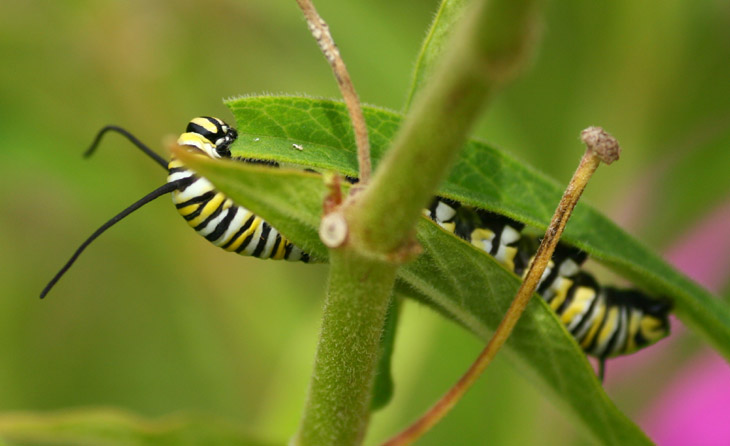
I did almost no shooting this week, but made up for it a little on Saturday when I had two students, though all of these images came from the second session. This month will be a new record for images uploaded, mostly because of this post, but there may still be more.
The opening image is a monarch butterfly caterpillar (Danaus plexippus,) the first I think I’ve seen around here, and one of two immediately visible in the UNC Botanical Garden. From the size, both were probably not far from forming a chrysalis, so I may be making more frequent trips out there to keep an eye on things, since this is one species I would desperately like to have a sequence of, given that the chrysalis is transparent and you can watch the colors develop from pale blue pupa (don’t ask me why this happens from a caterpillar of this color) into the orange and black of the adult butterfly.
[I have to note this as meaningless trivia. I often name my images something goofy and/or punny, partially because it helps me find them faster; this one was originally going to be named “MonarchMeal.jpg” before I realized that “FitForAKing.jpg” was the same thing but better. Moving on…]
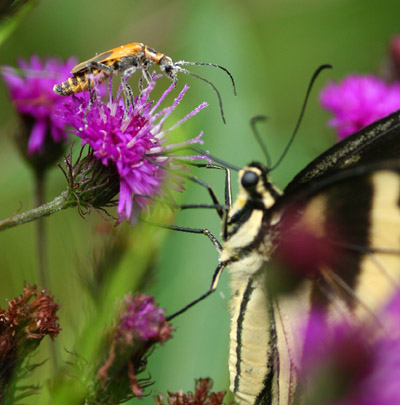 Here, a very-common eastern tiger swallowtail butterfly (Papilio glaucus) finds that its targeted nectar producer is already occupied by a variety of Chauliognathus beetle, probably one of the leatherwing species and also extremely common – I had no idea it was there when I leaned in to snag the butterfly as it landed. Chauliognathus can be found all over the place around here, and nothing seems to want to eat them – I have seen them openly ignored by mantids, lynx spiders, and assassin bugs. BugGuide.net had no mention of defenses, but the beetles do indeed have a way of deterring predators, a milky acid secreted on demand, though whether this is irritating or simply bad-tasting I cannot say. With enough upvotes (see the button below) I’ll pop one in my mouth and find out directly…
Here, a very-common eastern tiger swallowtail butterfly (Papilio glaucus) finds that its targeted nectar producer is already occupied by a variety of Chauliognathus beetle, probably one of the leatherwing species and also extremely common – I had no idea it was there when I leaned in to snag the butterfly as it landed. Chauliognathus can be found all over the place around here, and nothing seems to want to eat them – I have seen them openly ignored by mantids, lynx spiders, and assassin bugs. BugGuide.net had no mention of defenses, but the beetles do indeed have a way of deterring predators, a milky acid secreted on demand, though whether this is irritating or simply bad-tasting I cannot say. With enough upvotes (see the button below) I’ll pop one in my mouth and find out directly…

There have been quite a few Hemaris to be found this summer, which is very cool, but that’s not what this is. When the one I was following flew off, I switched over to the bumblebees raiding the flowers. This one just caught my attention as I was sorting images – it seemed so delighted to find another blossom waiting for it. Look – it even appears like its mouth is open, though they don’t actually have one that we would recognize.
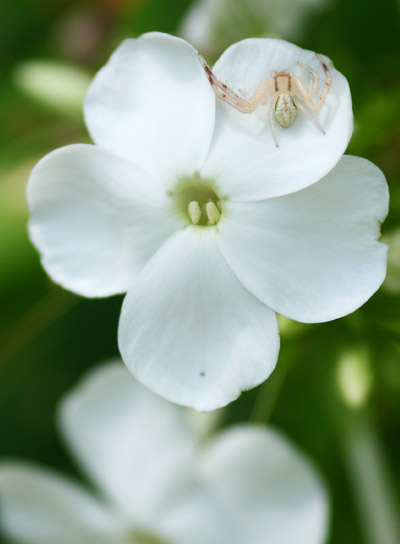 Given the lack of flowers in my immediate area, I’ve been planning on hunting down the crab spiders when I returned to the botanical garden, since it’s the only place with the yellow and white flowers that the crab spiders seem to prefer. As you can see here, I was successful, but not exactly as intended; I had planned for something a bit bigger. I didn’t go for the really detailed closeups – as I said earlier, that requires a lighting rig that I don’t lug around when I’m out with a student – but I’m going to take a stab at this being a Mecaphesa anyway.
Given the lack of flowers in my immediate area, I’ve been planning on hunting down the crab spiders when I returned to the botanical garden, since it’s the only place with the yellow and white flowers that the crab spiders seem to prefer. As you can see here, I was successful, but not exactly as intended; I had planned for something a bit bigger. I didn’t go for the really detailed closeups – as I said earlier, that requires a lighting rig that I don’t lug around when I’m out with a student – but I’m going to take a stab at this being a Mecaphesa anyway.
Overall, spiders seem to be relatively scarce this year, and I can’t say why – I’m inclined to blame the harsh winter that we had, which they’re not used to in this area, but that’s only an uneducated guess. Long before this time last year I had found several sizable specimens, including wolf spiders laden with their young, but have barely seen any this year. In my experience, however, arthropod species seem to have preferred seasons; one year the ladybeetles were prolific and the following year almost unseen. This year the mantids seemed to hatch very late. It may have a lot to do with what weather conditions exist at certain times, like during egg-laying and birthing season.
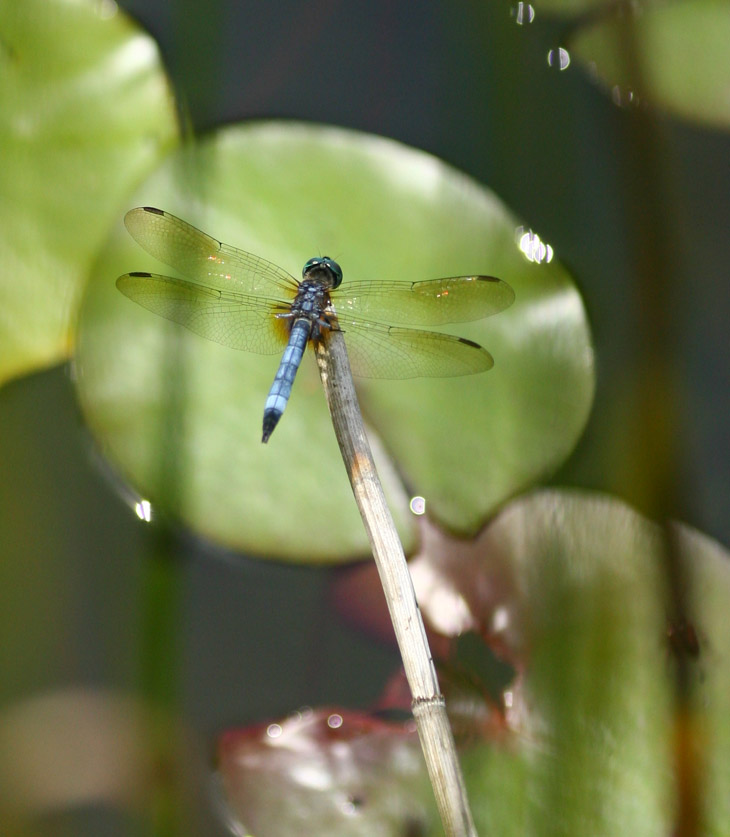
I went bigger for this one, since the wing detail wasn’t showing well in smaller versions – this is a blue dasher (Pachydiplax longipennis.) Dragonflies aren’t really hard to photograph, but doing something interesting with them is preferred. Here I experimented with shooting through a gap in the nearby reeds while centering the Odonata against a lily pad – the reeds are so far out of focus that they nearly vanish, but have some interesting effects with the specular highlights from the water anyway. The reeds are directly between me and the wings on both sides, but don’t really block the view at all – see this page for an explanation of how this occurs. This was tighter crop of a larger frame, and can be re-framed any number of ways, one of the benefits of shooting a bit wider.
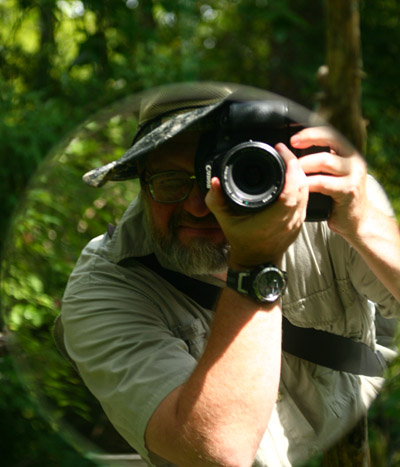 Another experiment, a gruesome one. At one point in the garden was an art installation that featured several round mirrors dangling from monofilament, twisting gently, and I crouched down and timed the rotation to snag a self-portrait. The focus is a little off, with good reason: when shooting a reflection, you are not focusing onto the surface that is reflecting, but past it all the way to the subject, the entire light distance. With a spinning mirror, however, there is only a fraction of a second when the distance is correct, too little time to snag autofocus, much less the manual focus I was using with this lens, so it’s actually surprising (to me, anyway) that it came out this well. I like the surreal aspect of it with the defocused edges of the mirror, done with no tricks at all, but don’t worry – it’s not going to be the end-of-month abstract shot.
Another experiment, a gruesome one. At one point in the garden was an art installation that featured several round mirrors dangling from monofilament, twisting gently, and I crouched down and timed the rotation to snag a self-portrait. The focus is a little off, with good reason: when shooting a reflection, you are not focusing onto the surface that is reflecting, but past it all the way to the subject, the entire light distance. With a spinning mirror, however, there is only a fraction of a second when the distance is correct, too little time to snag autofocus, much less the manual focus I was using with this lens, so it’s actually surprising (to me, anyway) that it came out this well. I like the surreal aspect of it with the defocused edges of the mirror, done with no tricks at all, but don’t worry – it’s not going to be the end-of-month abstract shot.
To make up for doing that to you, however, I offer the image below. The session was almost up, and I was lamenting that I had not seen any green anoles (Anolis carolinensis) at all, even though I was expressly keeping my eyes open for them because the garden is a favored habitat of theirs. And then, with two minutes to spare, this little specimen was found, posed fetchingly on a plant with its long (and surprisingly intact) tail hanging down. Even this big on the blog isn’t doing it justice, and I like how the toes are maintaining a negligent grip on its perch. I can only guess that it had just leapt to this locale from elsewhere, though I did not see or hear this occur, and only the gentle swinging of its tail alerted me to its presence. I’m pleased with it.























































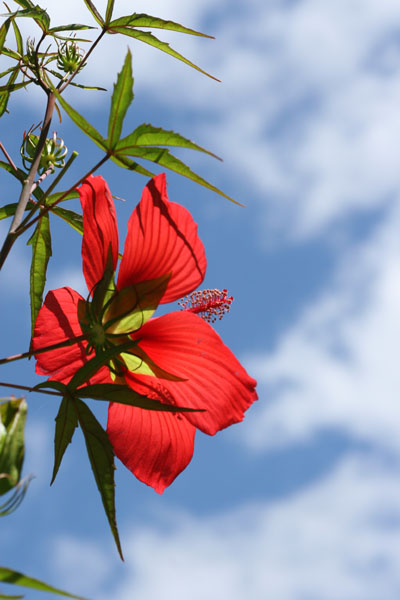 Today’s Monday color was shot exactly one year ago – tomorrow. I say this now so you have time to find a gift.
Today’s Monday color was shot exactly one year ago – tomorrow. I say this now so you have time to find a gift.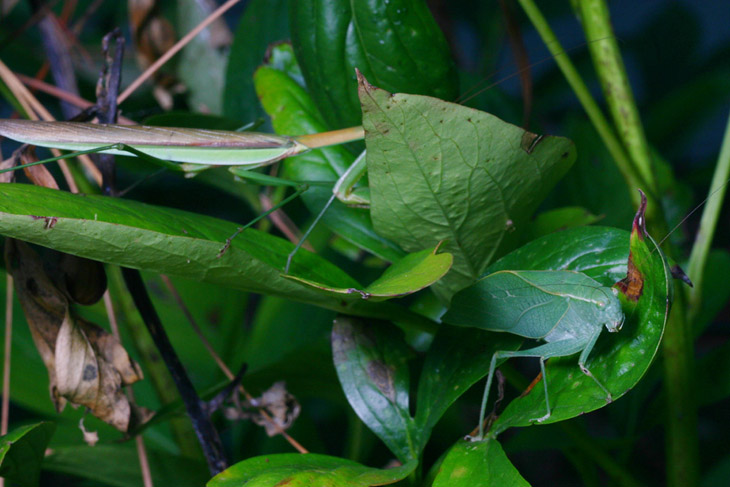
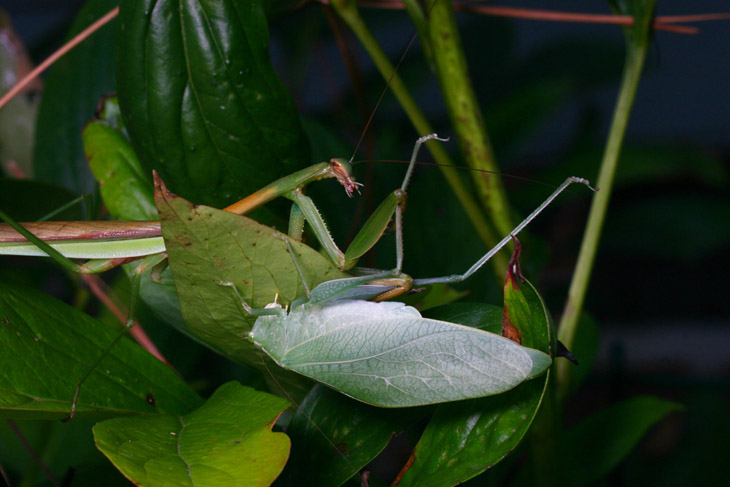
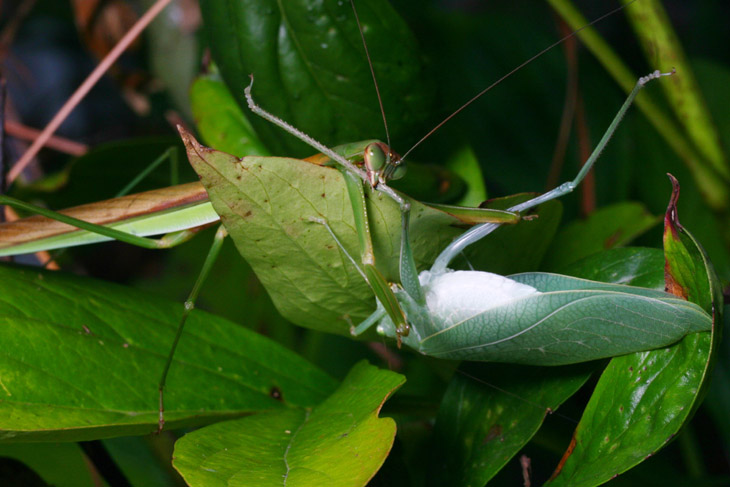




 We continue our quest to catch up with these images from only nine days ago – yeah, make any comments you like – when a torrential rain came through not long before sunset, followed immediately by a break in the clouds. Knowing what that meant, I trotted outside and, sure enough, there was a prominent rainbow, probably the best I’ve ever seen. It was the classic full-on double rainbow right across the sky, except that it was difficult to get it all in view at once, and I didn’t possess a wide-enough lens to do it justice (though I should have grabbed the film body, which didn’t have the crop factor.) After a few quick shots right out in front of the house, I trotted over to the pond and tried for more fartsy shots there, not having a lot of foreground interest to work with – these Canada geese (Branta canadensis) served when the great blue heron refused to pose and I couldn’t find the cormorant.
We continue our quest to catch up with these images from only nine days ago – yeah, make any comments you like – when a torrential rain came through not long before sunset, followed immediately by a break in the clouds. Knowing what that meant, I trotted outside and, sure enough, there was a prominent rainbow, probably the best I’ve ever seen. It was the classic full-on double rainbow right across the sky, except that it was difficult to get it all in view at once, and I didn’t possess a wide-enough lens to do it justice (though I should have grabbed the film body, which didn’t have the crop factor.) After a few quick shots right out in front of the house, I trotted over to the pond and tried for more fartsy shots there, not having a lot of foreground interest to work with – these Canada geese (Branta canadensis) served when the great blue heron refused to pose and I couldn’t find the cormorant. And now for something curious. When I first went outside, the rainbow was at its most brilliant, and there was a particular effect that was actually visible to the eye, though subtly – it was easy to think it might be imagined, but not only did others see it, I captured it in the images. It can, very faintly, be made out here, but stay with me because I’ll show you an enhanced version in a second. For now, look closely at the underside of the lower arc (the upper one is only faintly visible in this image, but it’s there.) Can you make out a faint band of green and a second band of violet down there immediately adjacent, ‘echoing’ the bow? It’s subtle enough here that it could easily disappear depending on your monitor/screen settings, so let’s take a look at an enhanced version from another frame.
And now for something curious. When I first went outside, the rainbow was at its most brilliant, and there was a particular effect that was actually visible to the eye, though subtly – it was easy to think it might be imagined, but not only did others see it, I captured it in the images. It can, very faintly, be made out here, but stay with me because I’ll show you an enhanced version in a second. For now, look closely at the underside of the lower arc (the upper one is only faintly visible in this image, but it’s there.) Can you make out a faint band of green and a second band of violet down there immediately adjacent, ‘echoing’ the bow? It’s subtle enough here that it could easily disappear depending on your monitor/screen settings, so let’s take a look at an enhanced version from another frame.
 As I said, it was difficult to find a lot of foreground interest to put against the bow. The cormorant that I’ve
As I said, it was difficult to find a lot of foreground interest to put against the bow. The cormorant that I’ve 
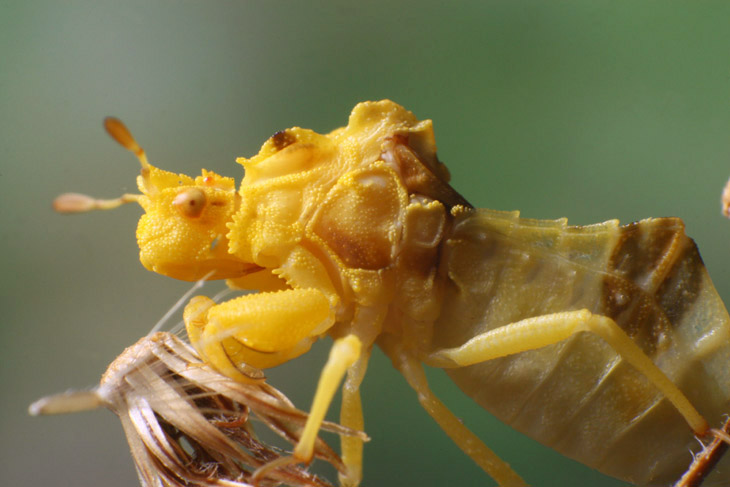
 Ambush bugs are predatory ‘true bugs,’ or Hemipterans, and usually find themselves a perch on a likely flower and await the appearance of pollinators. To say that they are sedentary is perhaps understating it; I have never seen one actually going anyplace, and even when provoked they are reluctant to give up their position. Both of these (if you can’t tell them apart that’s okay, neither can I) possessed wings and yet never made any attempt to fly away. This leads me to speculate that they rely almost entirely on their camouflage and caruncular exoskeleton for defense; usually they blend in much better than this, but we had no yellow flowers around to use as a setting. Also, since a lot of species count on movement rather than appearance in spotting prey, the tendency towards immobility that these bugs appear to possess might be sufficient all by itself. We’ll see more about that shortly. Right now, we’ll go in for a little closer look at the business end of things.
Ambush bugs are predatory ‘true bugs,’ or Hemipterans, and usually find themselves a perch on a likely flower and await the appearance of pollinators. To say that they are sedentary is perhaps understating it; I have never seen one actually going anyplace, and even when provoked they are reluctant to give up their position. Both of these (if you can’t tell them apart that’s okay, neither can I) possessed wings and yet never made any attempt to fly away. This leads me to speculate that they rely almost entirely on their camouflage and caruncular exoskeleton for defense; usually they blend in much better than this, but we had no yellow flowers around to use as a setting. Also, since a lot of species count on movement rather than appearance in spotting prey, the tendency towards immobility that these bugs appear to possess might be sufficient all by itself. We’ll see more about that shortly. Right now, we’ll go in for a little closer look at the business end of things.

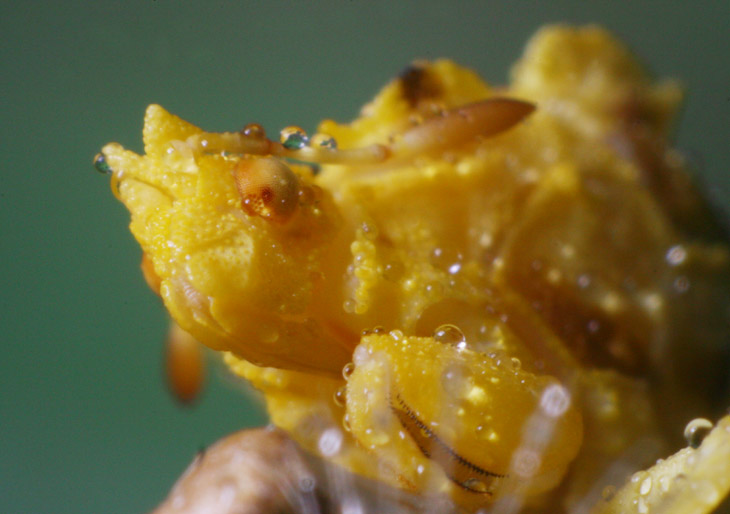
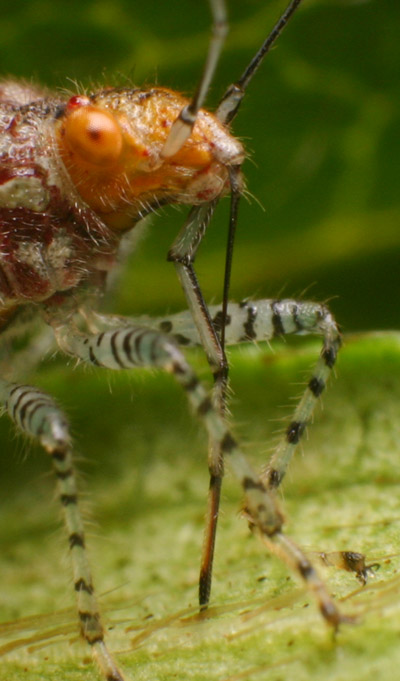 If you look closely at the base of the proboscis in the image above, right at the point of the ‘nose,’ you can see a little gap with a paler, ridged something in there. The proboscis is actually a multi-part appendage, as I discovered by accident in some previous macro pics, prompting me to seek more like the one at left. There is a hard outer ‘cutting/stabbing’ sheath, often articulated, called the labium. Fitting within it are the bits that do the actual drinking, looking like a fine thread even though there are actually four parts, collectively called the stylets, separately a pair each of mandibles and maxillae, terms you might recognize from just about any anatomy lesson, otherwise known as the lower and upper jaws respectively. The separate nature of the labium and stylets is nicely shown with this scentless plant bug (Niesthrea louisianica) that obligingly posed for me while feeding from a leaf. Diagrams and explanations of all this can be
If you look closely at the base of the proboscis in the image above, right at the point of the ‘nose,’ you can see a little gap with a paler, ridged something in there. The proboscis is actually a multi-part appendage, as I discovered by accident in some previous macro pics, prompting me to seek more like the one at left. There is a hard outer ‘cutting/stabbing’ sheath, often articulated, called the labium. Fitting within it are the bits that do the actual drinking, looking like a fine thread even though there are actually four parts, collectively called the stylets, separately a pair each of mandibles and maxillae, terms you might recognize from just about any anatomy lesson, otherwise known as the lower and upper jaws respectively. The separate nature of the labium and stylets is nicely shown with this scentless plant bug (Niesthrea louisianica) that obligingly posed for me while feeding from a leaf. Diagrams and explanations of all this can be 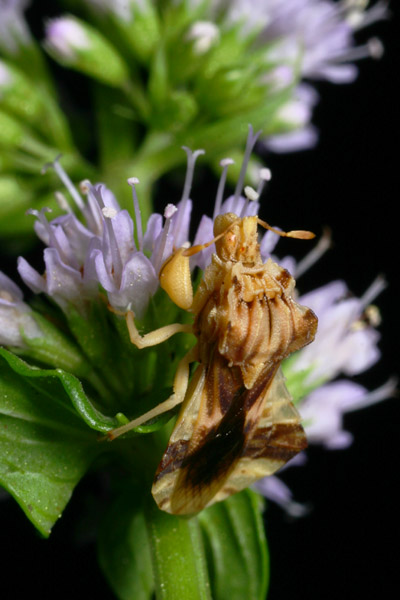 After the photo session, I took both ambush bug specimens out and tried to find appropriate places for them. One went onto the flowers of the spearmint plants, and the other onto a geranium bloom – like I said, we don’t have any yellow flowers around here. The geranium was apparently unacceptable, since I haven’t seen it there since, but the one on the mint seemed to be okay with the choice, considering that it is still there as I type this, a week since its release – that’s it in the pic, obviously not camouflaged terribly well, yet still in flattering colors (if I’m any judge, which I’m probably not.) Faintly visible in this image is the red spot on the back of the ‘skull,’ also visible in one of the photos above and the one with the scentless plant bug. These are small simple eyes called ocelli, primarily believed to help flying insects maintain stable flight. If you roll back a few posts, you can see them on the mantises and the cicada as well.
After the photo session, I took both ambush bug specimens out and tried to find appropriate places for them. One went onto the flowers of the spearmint plants, and the other onto a geranium bloom – like I said, we don’t have any yellow flowers around here. The geranium was apparently unacceptable, since I haven’t seen it there since, but the one on the mint seemed to be okay with the choice, considering that it is still there as I type this, a week since its release – that’s it in the pic, obviously not camouflaged terribly well, yet still in flattering colors (if I’m any judge, which I’m probably not.) Faintly visible in this image is the red spot on the back of the ‘skull,’ also visible in one of the photos above and the one with the scentless plant bug. These are small simple eyes called ocelli, primarily believed to help flying insects maintain stable flight. If you roll back a few posts, you can see them on the mantises and the cicada as well.


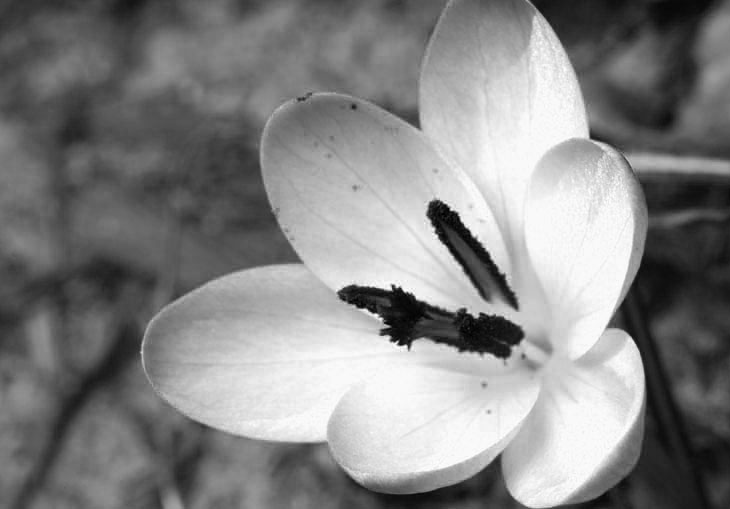
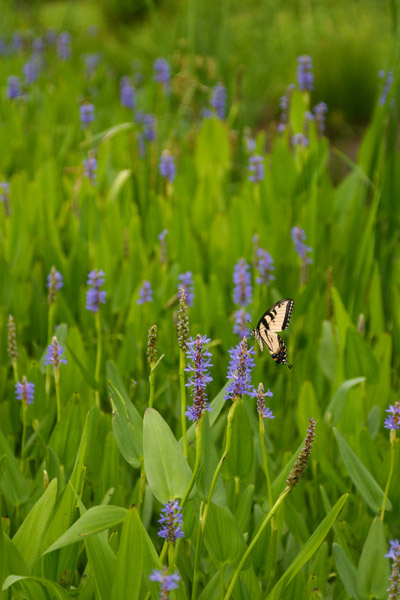 Our attempts to catch up continue, as we hearken back to six days ago and a visit to a nearby pond. A variation of this view was seen
Our attempts to catch up continue, as we hearken back to six days ago and a visit to a nearby pond. A variation of this view was seen  The light was just barely bright enough to shine through the broad leaves, and this suspicious little oval shadow is something that I’ve seen before. Only about the size of the top joint of your thumb, it was the right size and the right shape for a typical position of a treefrog, since they often sit with their legs tucked tightly in, much like cats. This was deep in a thick patch of the water plants, however, and while I could manage a decent view from this side, the other side was going to prove difficult.
The light was just barely bright enough to shine through the broad leaves, and this suspicious little oval shadow is something that I’ve seen before. Only about the size of the top joint of your thumb, it was the right size and the right shape for a typical position of a treefrog, since they often sit with their legs tucked tightly in, much like cats. This was deep in a thick patch of the water plants, however, and while I could manage a decent view from this side, the other side was going to prove difficult.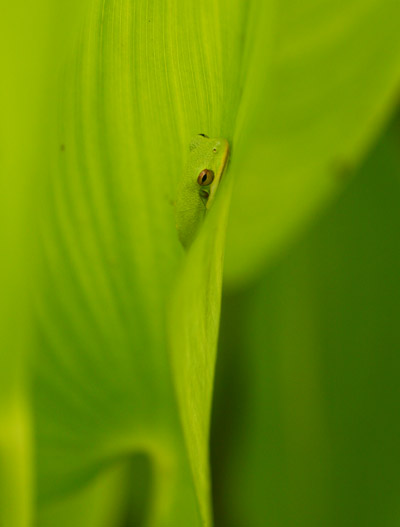 In time, I managed to get to a position that was just barely adequate, seeing through a gap in the surrounding plants right along the edge of the leaf, but enough to reveal that the source of the shadow was exactly as suspected. I told you the color was a close match. This green treefrog (Hyla cinerea) was about half of adult size, being less than 3 cm in body length. I wanted to work with the lower contrast and specific colors of natural light, so I left the flash in the bag, but the overcast conditions meant I was once again shooting mostly at largest aperture (f4 in this case, the wonderful Mamiya 80mm macro that fits on my Canon cameras with a custom mount.) This had the effect that, with the short focus, the frog almost seems to blur into the leaf itself. I might have to do some more experiments with short depth-of-field in these situations…
In time, I managed to get to a position that was just barely adequate, seeing through a gap in the surrounding plants right along the edge of the leaf, but enough to reveal that the source of the shadow was exactly as suspected. I told you the color was a close match. This green treefrog (Hyla cinerea) was about half of adult size, being less than 3 cm in body length. I wanted to work with the lower contrast and specific colors of natural light, so I left the flash in the bag, but the overcast conditions meant I was once again shooting mostly at largest aperture (f4 in this case, the wonderful Mamiya 80mm macro that fits on my Canon cameras with a custom mount.) This had the effect that, with the short focus, the frog almost seems to blur into the leaf itself. I might have to do some more experiments with short depth-of-field in these situations…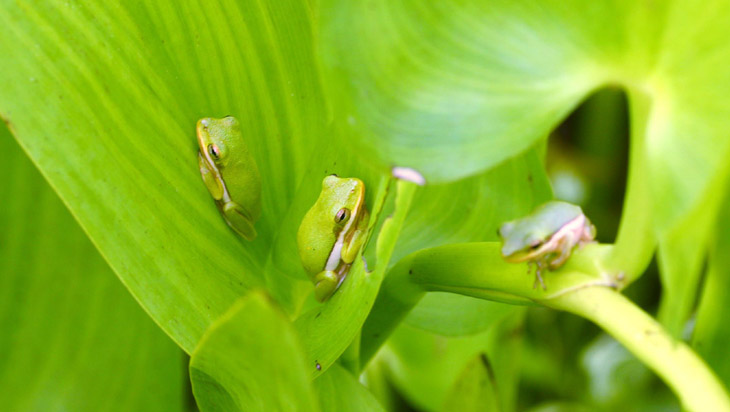
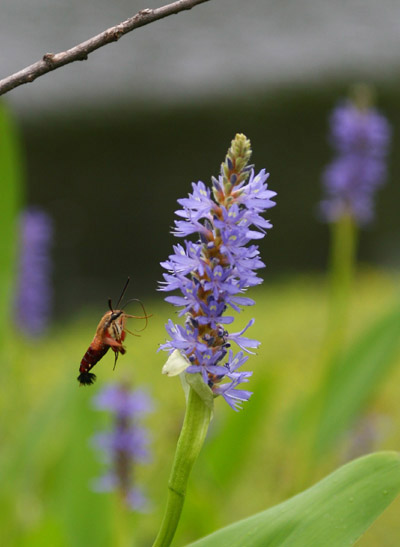 While all of this was going on, I was often in the middle of bumblebees feeding from the flowers, and what I suspect was a solitary clearwing moth, seen several times over. I did not get a close enough image to pin down the exact species (the color of the legs is the key trait,) but I think it was Hemaris thysbe – certainly genus Hemaris, anyway. They’re fun insects to watch, but hyperactive enough to make good photos challenging, not helped at all by the fact that they never land when feeding, instead hovering at the flowers like the hummingbirds that they often mimic. They also mimic bumblebees, and this trait is enough to distinguish them easily because bumblebees always land on the flowers.
While all of this was going on, I was often in the middle of bumblebees feeding from the flowers, and what I suspect was a solitary clearwing moth, seen several times over. I did not get a close enough image to pin down the exact species (the color of the legs is the key trait,) but I think it was Hemaris thysbe – certainly genus Hemaris, anyway. They’re fun insects to watch, but hyperactive enough to make good photos challenging, not helped at all by the fact that they never land when feeding, instead hovering at the flowers like the hummingbirds that they often mimic. They also mimic bumblebees, and this trait is enough to distinguish them easily because bumblebees always land on the flowers. And finally, the last frog captured that morning, in a session that lasted all of fifteen minutes – I just stopped briefly to check on things while running other errands. Yes, this was the last stop before returning home with my filthy feet – I have a little decorum left, and won’t go to public places looking like some derelict. Or even more so than necessary, anyway.
And finally, the last frog captured that morning, in a session that lasted all of fifteen minutes – I just stopped briefly to check on things while running other errands. Yes, this was the last stop before returning home with my filthy feet – I have a little decorum left, and won’t go to public places looking like some derelict. Or even more so than necessary, anyway.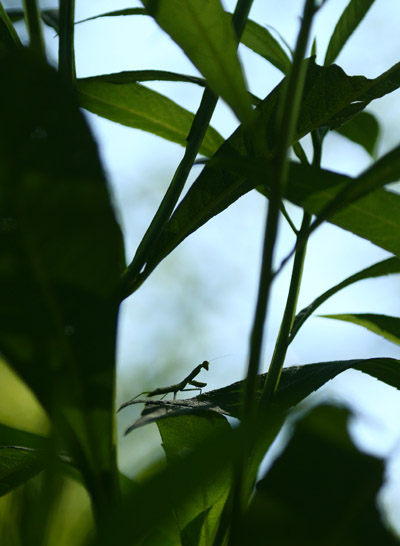 In the past week, I shot about 600 images in four sessions or so, which partially explains the lack of posts. So we’ll play catch-up over a couple of days, and in the process see the difference in approach used, depending on the subject and circumstances.
In the past week, I shot about 600 images in four sessions or so, which partially explains the lack of posts. So we’ll play catch-up over a couple of days, and in the process see the difference in approach used, depending on the subject and circumstances.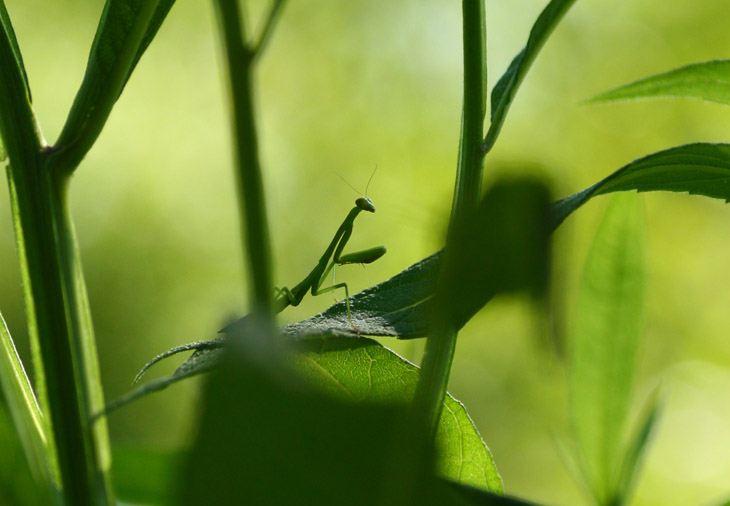
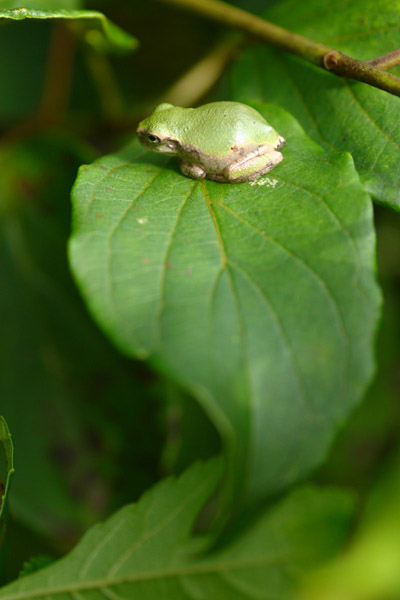 I have a few images of this eentsy treefrog that show the face better, but this one gives a dramatic impression of scale with the entire leaf visible. This is likely a squirrel treefrog (Hyla squirella,) and probably the same species captured
I have a few images of this eentsy treefrog that show the face better, but this one gives a dramatic impression of scale with the entire leaf visible. This is likely a squirrel treefrog (Hyla squirella,) and probably the same species captured 
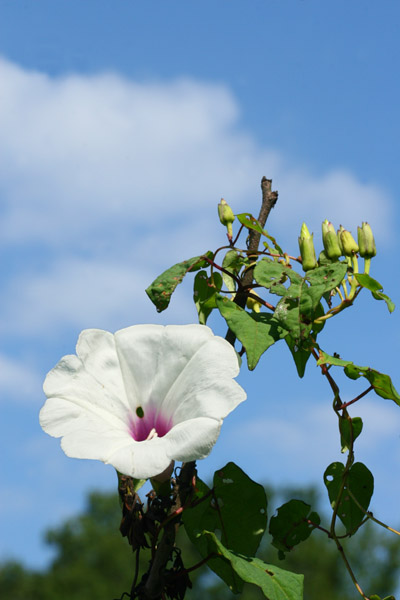 This dragonfly, an eastern pondhawk (Erythemis simplicicollis,) was the first species captured that day, before the sun had risen enough to break through most of the trees and evaporate off the dew – while I admit to plying a misting bottle in situations where it can add to the image, the moisture here is natural, and fairly common with dragonflies in the right conditions. And since dragonflies need a good level of warmth in their wing muscles along the thorax to fly (the reason why they’re always found perching on reeds in bright sunlight,) any this covered in dew are unlikely to fly away at a close approach. However, with a very slow approach, you can actually get them to perch on a fingertip at any time, because they view speed as a threat and glacial movements simply don’t register in this way. Go straight in towards the head, and gently push up against the face or forelegs when you make contact – no, they don’t bite.
This dragonfly, an eastern pondhawk (Erythemis simplicicollis,) was the first species captured that day, before the sun had risen enough to break through most of the trees and evaporate off the dew – while I admit to plying a misting bottle in situations where it can add to the image, the moisture here is natural, and fairly common with dragonflies in the right conditions. And since dragonflies need a good level of warmth in their wing muscles along the thorax to fly (the reason why they’re always found perching on reeds in bright sunlight,) any this covered in dew are unlikely to fly away at a close approach. However, with a very slow approach, you can actually get them to perch on a fingertip at any time, because they view speed as a threat and glacial movements simply don’t register in this way. Go straight in towards the head, and gently push up against the face or forelegs when you make contact – no, they don’t bite.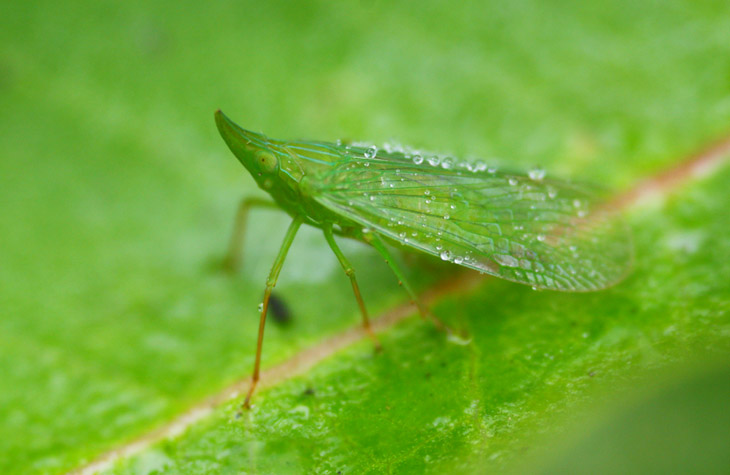
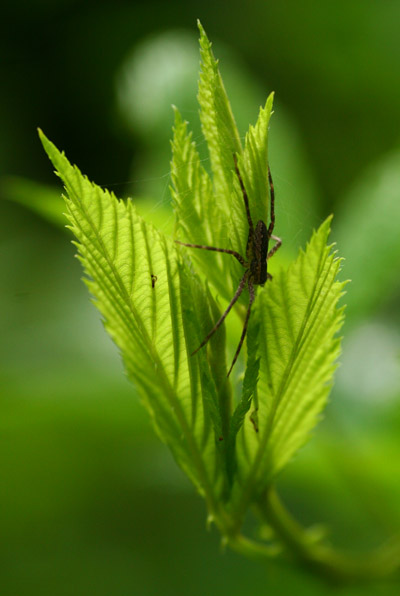 The dew had already boiled off by the time we found several nursery web spiders (Pisaurina mira,) all perched in similar positions atop their own stalks of raspberry plants. To me, there’s something evocative of the early morning sunlight shining through yet the spider appears to be shunning it. While this is likely true, because it will help them avoid birds, I cannot say this definitively, especially since we only had the one angle to work from, so couldn’t test the theory by finding any others on the sunny side of the plants.
The dew had already boiled off by the time we found several nursery web spiders (Pisaurina mira,) all perched in similar positions atop their own stalks of raspberry plants. To me, there’s something evocative of the early morning sunlight shining through yet the spider appears to be shunning it. While this is likely true, because it will help them avoid birds, I cannot say this definitively, especially since we only had the one angle to work from, so couldn’t test the theory by finding any others on the sunny side of the plants.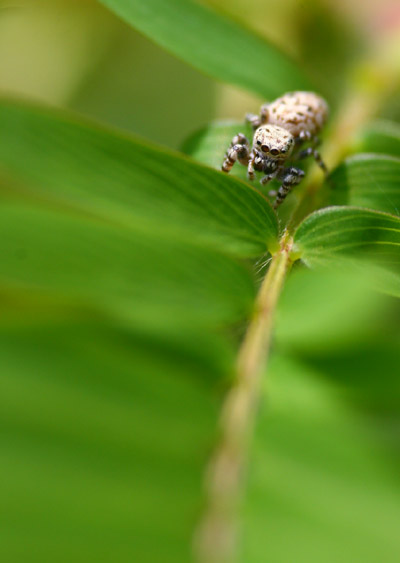 We close with another spider, this one a jumping spider, likely
We close with another spider, this one a jumping spider, likely